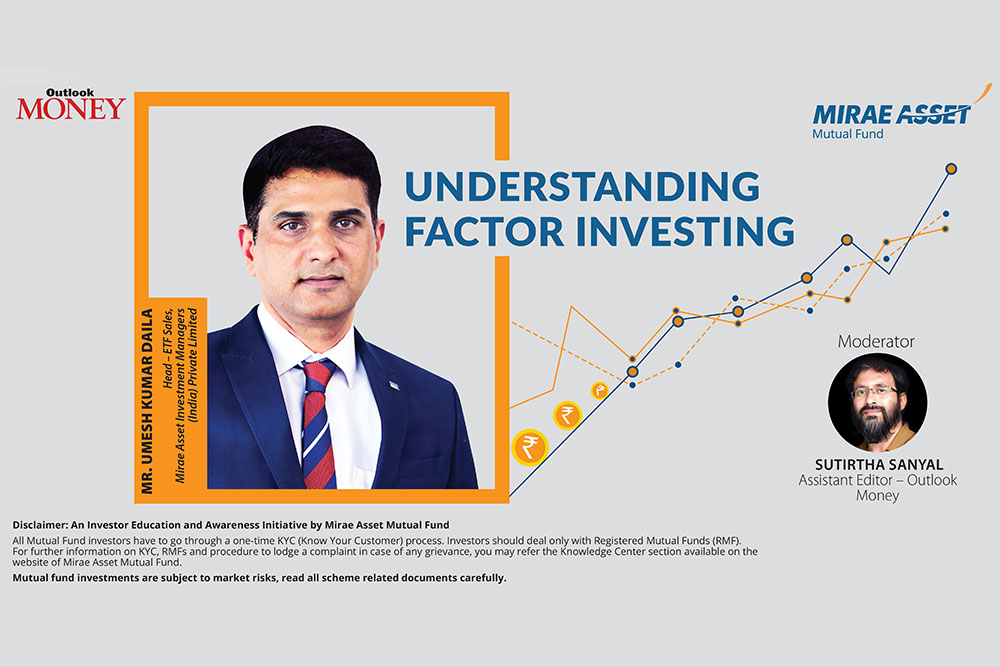Factors are the foundations of investing that define the broad drivers of returns across asset classes. Investing in factors can help improve portfolio outcomes, reduce volatility and enhance diversification.
In a recent discussion with Outlook Money, Umesh Kumar Daila, head – ETF sales, Mirae Asset Investment Managers India Pvt Ltd, demystified factor investing, the strategies one should adopt while opting for factor-based investing, and the typical asset allocation one should follow. He was in discussion with Sutirtha Sanyal, assistant editor, Outlook Money.
Here are some edited excerpts from the discussion.
Could you help our viewers understand factor investment strategy?
Factor investing is an investment strategy where the stocks are selected based on well-researched attributes, which help in terms of growth or returns. For instance, selecting a stock based on lesser volatility, lesser risk, equal weight, or momentum can be considered as factor investing.
There are multiple factors which are being used globally. In India, few have been introduced, such as low volatility factor or quality factor.
Where does factor investing stand if we compare it with two popular investment strategies –“Active and Passive”?
Smart beta strategies allow investors to retain many benefits of passive investing while also seeking potential outperformance from the underlying index. The selection of stocks is done by factors, which have worked well historically, and given that the markets are growing, these kind of strategies will play a more important role.
Factor investing is new in India, but how successful is it abroad?
As on February 28, 2023, globally, there are close to 1,280 smart beta products listed around 2,655 listings. The total assets under management (AUM) is around $1.28 trillion. There are around 201 ETF providers who have listed products across 49 exchanges globally, in 38-39 countries.
Smart beta ETFs have witnessed more than $8.3 billion of inflows in last two months of 2023, and if the trend continues, this will be the 31st month of net inflows of smart beta ETFs.
In a country like India, there is always scope for a fund manager to generate alpha. So, what’s the benefit of factor investing?
Let’s say, you choose a specific factor, such as low volatility, and the markets are turbulent. In those scenarios, low volatility kind of factors might play well, and from an investor perspective, especially in India, which is still an alpha-driven market, for completing a portfolio, these kind of factors are playing an important role.
What are the things investors should keep in mind while opting for factor-based investment?
Smart-beta factors are based on pre-set rules, and these will remain unchanged across market cycles. So investors will have to keep in mind what sort of factors he/she is looking for and whether they are going for a short-term call or a long-term perspective. Factor investing will give good diversification, and so, investors can look at choosing factors depending on how the market will behave for his/her portfolio.
How can an investor decide on factor investing while building a portfolio, as different factor follows different approach such as high beta, lower valuation and so on….?
Investor should match his/her risk profile with the investment. Every factor has a different kind of risk appetite and investor should look for that. For instance, if the market in a bull phase, then momentum factors might do well, and the investor will benefit as the selection will be based on stocks which are showing higher momentum than the rest of the market.
Similarly, in a downturn market, investor can look for low-volatility factor, which will give him an exposure to those companies which are less volatile in the turbulent market.
Who are the typical investors in the Indian market?
There has been a steady growth in mutual fund investor account, and across categories. From the perspective of assets under management (AUM), 90 per cent is by institutional investors, but when we talk of the number of accounts, close to 98 per cent of folios belong to retail investors. Similar kind of trend exists in factor investing as well.
What should be the ideal portfolio allocation?
This should be based on one’s investment objective and goal. The call can be short-term or long-long depending on the investor’s outlook. So, an investor can relook at his/her portfolio to see what factors are missing and accordingly include them to give a kicker and stability to his portfolio.
Disclaimer
An Investor Education & Awareness Initiative by Mirae Asset Mutual Fund.
For information on one-time KYC (Know Your Customer) process, Registered Mutual Funds and procedure to lodge a complaint, refer to the knowledge center section available on the website of Mirae Asset Mutual Fund
Mutual Fund investments are subject to market risks, read all scheme related documents carefully.

